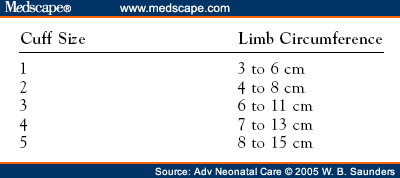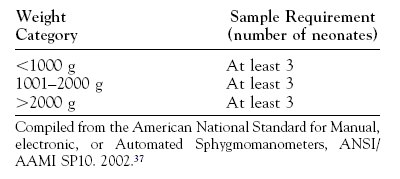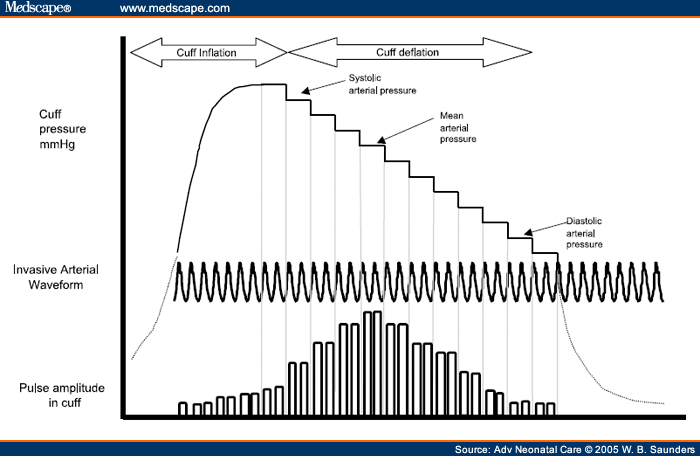NIBP Measurement
Noninvasive BP measurement involves placing a cuff around a limb to compress an artery. Methods of NIBP determination include:
Oscillometry
Auscultation
Doppler ultrasound
Palpation
Of these Methods, oscillometry is most often used in newborn intensive care units.[21] Some advantages of oscillometry over the auscultatory method are lack of observer variation, accuracy, the ability to take an NIBP on a cycled time without disturbing the child, and the simultaneous display of pulse rate.[22] Auscultatory devices are used infrequently in infants because the Korotkoff sounds are often unobtainable.[23] The Doppler method is time consuming and labor intensive because its probe should be held in place while the BP is being taken.[24] Noninvasive BP taken by palpation of peripheral pulses provides only systolic pressure.[22] Table 2 compares and contrasts the oscillometric and auscultatory Methods of BP measurement.
Although many types of monitors use the same basic technique, the integration of the oscillometric method within an NIBP algorithm may differ substantially between manufacturers. All BP monitors on the market must have proven accuracy. See Sidebar 1 for a Discussion of a BP device accuracy study.
How devices determine accurate NIBP values and how users are instructed to operate the monitors may differ between manufacturers. Before using any monitor, the neonatal nurse must first verify its instructions for use supplied by the manufacturer. The description and use of the oscillometric method, monitor, and cuff in this article specifically refer to DINAMAP monitors (GE Healthcare Technologies, Tampa, Fla); information may not apply to other oscillometric NIBP monitors.
In the DINAMAP monitors, NIBP measurement is accomplished by a sensitive transducer that measures static pressure and pressure oscillations received and transmitted by the cuff (Fig 2). After inflating the cuff, the monitor begins to deflate it and measures systolic pressure, MAP, and diastolic pressure. Mean arterial pressure is generally the lowest cuff pressure with the greatest average oscillation amplitude. Systolic and diastolic BP are determined by identifying the cuff pressures where the amplitudes of oscillations are specific ratios of the maximum oscillation amplitude.[7] When the diastolic pressure has been determined, the monitor finishes deflating the cuff and posts the values to a display.
Noninvasive blood pressure determination sequence. Systolic and diastolic BPs are estimated by identifying the cuff pressures where the amplitudes of oscillations are specific ratios of the maximum oscillation amplitude. Mean arterial pressure is generally the lowest cuff pressure with the greatest average oscillation amplitude. The pulses detected from the cuff (oscillations) are shown below the corresponding intra-arterial pulses. Notice that the intra-arterial line pulses are uniform, and the oscillations show a clear pattern of increase and decrease in pulsation strength; no artifact is detected during this determination. Reprinted with permission from GE Healthcare Technologies.
One of the advantages of the oscillometric method is the simultaneous measurement of pulse rate. Clinicians can compare pulse rates from an NIBP monitor to electrocardiographic (ECG) heart rates to assess the reliability of the NIBP. The pulse rate derived through an oscillometric method has been reported to be a valid indicator of heart rate;[25] however, when comparing the NIBP pulse rate with the heart rate derived from an ECG waveform, it is important to remember that these numbers may differ. The NIBP parameter measures actual peripheral pulses, not electrical signals or contractions from the heart; differences may occur because cardiac electrical signals occasionally fail to produce a peripheral pulse. Differences may also occur if the infant has poor peripheral perfusion. If the infant's beat-to-beat pulse amplitude varies significantly (e.g., because of pulsus alternans, atrial fibrillation, or the use of a rapid-cycling artificial ventilator), BP and pulse rate readings can be erratic. In these cases use an alternate measuring method for confirmation.[26]
Adv Neonatal Care. 2005;5(5):252-261. © 2005 W.B. Saunders
Cite this: Basic Principles of Noninvasive Blood Pressure Measurement in Infants - Medscape - Oct 01, 2005.












Comments